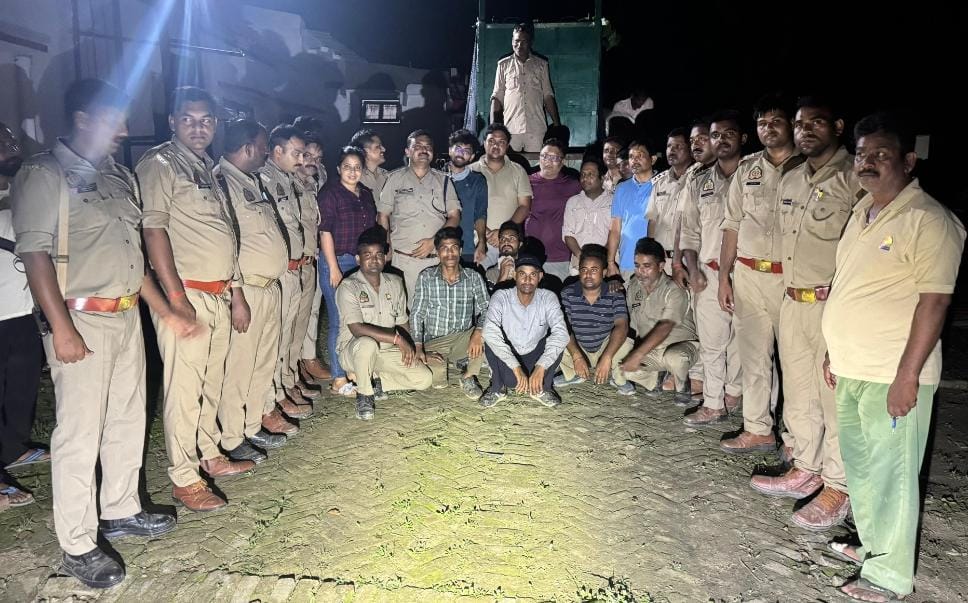For 46 days, a single tigress turned 22 villages of Pilibhit into islands of fear. From sugarcane fields taller than a man to muddy riverbanks and scattered hamlets, her stealthy prowl left behind a trail of panic and tragedy. Three villagers lay dead; two more were mauled. Families refused to step onto their own farms. Schools stayed shut. Nights became watch posts for restless eyes scanning the dark.
Into this tense silence stepped Bharat Kumar DK, a 2022 batch IFS officer and the Divisional Forest Officer of Pilibhit. It wasn’t his first tiger conflict. Pilibhit Tiger Reserve has lost 53 tigers in the past 13 years, but this hunt was different. This tigress was young, barely three years old, but dangerously unpredictable. The rescue had to be clean. Or blood would spill again.
In an exclusive conversation with Indian Masterminds, the officer shared chilling details about the 11-hour rescue operation conducted to capture the man-eating beast of Pilibhit.
THE TIGRESS WITH MANY SHADOWS
Since June 9, her stripes flickered in and out of camera traps. She stalked gnarled sugarcane fields, the perfect hideout for a cat that could vanish behind 7-foot stalks. Bharat Kumar’s team found pugmarks in the mud, only for the monsoon rain to wash them away. She paddled through the Khakhra and Devan rivers, where shallow currents made tracking impossible. One night she’d be near Mewatpur village, and the next she’d appear seven kilometres away, an aerial jump that meant 30 kilometres of ground chase for the forest staff.
“The tracking of the tiger was very difficult because it was raining continuously,” Bharat Kumar explains. “The pugmarks used to get erased, and the scent marks would disappear.”
Even when they found the trail, it could vanish overnight as the tigress moved through rivers and cane fields like a whisper.

OPERATION THIRD EYE
It was clear. This hunt would need more than eyes in the bushes. The operation was named Third Eye as drones hovered day and night, their thermal lenses sweeping the cane jungles where the tigress slinked unseen.
Deputy Director Manish Singh crafted the chase blueprint. WWF’s Bagh Mitras, local ‘tiger friends’ trained to read the forest like an open book, stood by his side. Barely hours before the final push, these Bagh Mitras had returned from Maharashtra’s Tadoba reserve. Instead of resting, they grabbed their sticks and slipped back into the wet grass to guide teams through the thickets.
“The main problem was that it was moving a lot from one place to another. In one night, it used to travel seven to ten kilometres in aerial distance, which means 30–40 kilometres on the road. Each morning, our teams scrambled to reposition, only to find fresh pugmarks kilometres away again,” Kumar shared with Indian Masterminds.

THE FINAL STAND AT DANDIA
Dawn, July 24. A flicker in the drone feed. The tigress was back near Dandia village. Bharat Kumar, Manish Singh, and their joint force of 200 forest staff sealed the perimeter, a one-kilometre ring along the Khakhra River, where reeds and rain made every footstep treacherous.
Inside the cordon, two expert vets, Dr. Nasir from Kanpur and Dr. Daksh Gangwar, waited with tranquillizer guns ready. By 6:30 AM, the teams found fresh pugmarks. Police blocked nearby roads to keep villagers at bay. One wrong shout, and the tigress could bolt.
Hours ticked by. She slipped near trap baits, live goats tethered to lure her in, but turned away. Drone batteries drained. The monsoon mist thickened. Still, the teams combed every inch of cane and muddy trench. It took eleven grinding hours.
“The rescue operation started at 5:30,” Bharat Kumar recounts. “Our staff spotted her, and we reached the spot at 6:30. We darted her and rescued her. We put her in the cage at 7:30.”
Eleven hours from first track to final capture, and finally, the striped ghost slumped inside the iron cage as dusk fell.

A FOREST NEVER SLEEPS
This was no ordinary rescue. In 13 years, Pilibhit has lost 26 tigers to death, and 27 more have been shifted to other forests. Bharat Kumar’s operation marks the 23rd tiger rescue since March 2014, a stark reminder of the constant tension where man and tiger collide.
But the story doesn’t end in a cage. This tigress, with her odd behaviour, venturing too close to humans and ignoring bait, will likely never roam free again.
“She has a weird kind of peculiar behaviour. We have requested the chief wildlife warden not to release her in protected areas or forests. She should be sent to a zoo or rescue centre,” Bharat Kumar told Indian Masterminds.
Through the sugarcane fields of Pilibhit, Bharat Kumar DK and his team chase not just tigers; they chase time. Every roar that echoes through these fields is a reminder: the fight for coexistence is never over. Tigers don’t understand village borders. And men like Bharat Kumar know they cannot sleep until the last paw-print is back where it belongs: deep in the wild, far from frightened villagers, hidden once more in the whispering green.






























